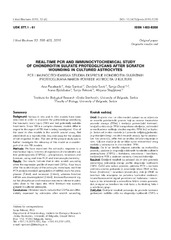Приказ основних података о документу
PCR i imunocitohemijska studija ekspresije hondroitin-sulfatnih proteoglikana nakon povrede astrocita u kulturi
Real-time PCR and immunocytochemical study of chondroitin sulfate proteoglycans after scratch wounding in cultured astrocytes
| dc.creator | Savić, Danijela | |
| dc.creator | Parabucki, Ana | |
| dc.creator | Bjelobaba, Ivana | |
| dc.creator | Santrač, Anja | |
| dc.creator | Dacić, Sanja | |
| dc.creator | Peković, Sanja | |
| dc.creator | Stojiljković, Mirjana | |
| dc.date.accessioned | 2015-08-28T10:26:51Z | |
| dc.date.available | 2015-08-28T10:26:51Z | |
| dc.date.issued | 2013 | sr |
| dc.date.issued | 2013 | |
| dc.identifier.issn | 1452-8258 | sr |
| dc.identifier.other | Rad_konverzija_546 | sr |
| dc.identifier.uri | https://radar.ibiss.bg.ac.rs/handle/123456789/507 | |
| dc.description.abstract | Background: Various in vivo and in vitro models have been described in order to elucidate the pathobiology underlying the traumatic brain injury (TBI) and test potentially suitable treatments. Since TBI is a complex disease, models differ in regard to the aspect of TBI that is being investigated. One of the used in vitro models is the scratch wound assay, first established as a reproducible, low-cost assay for the analysis of cell migration in vitro. The aim of the present study was to further investigate the relevancy of this model as a counterpart of in vivo TBI models. Methods: We have examined the astrocytic response to a mechanical injury in terms of expression of chondroitin sulfate proteoglycans (CSPGs) - phosphacan, neurocan and brevican, using real-time PCR and immunocytochemistry. Results: Our results indicate that in vitro scratch wounding alters the expression profile of examined CSPGs. Four hours after the scratch injury of the astrocytic monolayer, real-time PCR analysis revealed upregulation of mRNA levels for phosphacan (3-fold) and neurocan (2-fold), whereas brevican mRNA was downregulated (2-fold). Immunofluorescent signal for phosphacan and neurocan was more intense in astrocytes close to the injury site, while brevican was scarcely present in cultured astrocytes. Conclusions: Obtained results indicate that CSPGs are differentially expressed by astrocytes after scratch wounding, demonstrating that the scratch wound model might be suitable for investigation of astrocyte-derived response to injury. | en |
| dc.description.abstract | Uvod: Brojni in vivo i in vitro modeli opisani su sa ciljem da se rasvetle patobiološki procesi koji su osnova traumatske povrede mozga (TPM) i testiraju potencijalni tretmani. Imajući u vidu da je TPM kompleksno oboljenje, ovi modeli se međusobno razlikuju shodno aspektu TPM koji se ispituje. Jedan od in vitro modela je i povreda ćelijskog jednosloja grebanjem (engl. 'scratch wound' assay), isprva ustanovljen kao ponovljiv, jeftin test za analizu celijske migracije in vitro. Cilj ove studije je da se bliže ispita relevantnost ovog modela u odnosu na in vivo modele TPM. Metode: Da bi se istražio odgovor astrocita na mehaničku povredu, praćena je ekspresija odabranih hondroitin-sulfatnih proteoglikana (CSPG) - fosfakana, neurokana i brevikana, korišćenjem PCR u realnom vremenu i imunocitohemije. Rezultati: Dobijeni rezultati su pokazali da in vitro povreda astrocitnog jednosloja menja profile ekspresije ispitivanih CSPG. Četiri sata nakon povrede, primena PCR u realnom vremenu analize pokazala je povećanje nivoa iRNK za fosfakan (trostruko) i neurokan (dvostruko), dok je iRNK za brevikan bila smanjena na polovinu kontrolne vrednosti. Imunofluorescentni signal poreklom od fosfakana i neurokana je bio intenzivniji u astrocitima bližim mestu povrede, dok je signal za brevikan bio slab kako u kontrolnoj, tako i u ozleđenoj grupi. Zaključak: Dobijeni rezultati pokazuju da povreda izazvana grebanjem različito utiče na ekspresiju ispitivanih CSPG u astrocitima, sto ukazuju da ovaj model može biti pogodan za ispitivanje odgovora astrocita na povredu. | sr |
| dc.description.sponsorship | Projekat ministarstva br. III 41014 | sr |
| dc.language.iso | eng | sr |
| dc.rights | openAccess | sr |
| dc.source | Journal of Medical Biochemistry | sr |
| dc.subject | reactive astrocytes | ENG |
| dc.subject | reaktivni astrociti | SRP |
| dc.subject | hondroitin-sulfatni proteoglikani | SRP |
| dc.subject | chondroitin sulfate proteoglycans | ENG |
| dc.subject | in vitro model | ENG |
| dc.subject | in vitro model | SRP |
| dc.subject | scratch-wound assay | ENG |
| dc.subject | 'scratch-wound' test | SRP |
| dc.subject | ekspresija gena | SRP |
| dc.subject | gene expression | ENG |
| dc.title | PCR i imunocitohemijska studija ekspresije hondroitin-sulfatnih proteoglikana nakon povrede astrocita u kulturi | sr |
| dc.title | Real-time PCR and immunocytochemical study of chondroitin sulfate proteoglycans after scratch wounding in cultured astrocytes | en |
| dc.type | article | sr |
| dc.rights.license | ARR | |
| dcterms.abstract | Стојиљковић, Мирјана; Бјелобаба, Ивана; Пековић, Сања; Парабуцки, Aна; Сантрач, Aња; Савић, Данијела; Дацић, Сања; ПЦР и имуноцитохемијска студија експресије хондроитин-сулфатних протеогликана након повреде астроцита у култури; ПЦР и имуноцитохемијска студија експресије хондроитин-сулфатних протеогликана након повреде астроцита у култури; | |
| dc.citation.issue | 4 | sr |
| dc.citation.volume | 32 | sr |
| dc.citation.spage | 398 | sr |
| dc.citation.epage | 405 | sr |
| dc.type.version | publishedVersion | sr |
| dc.identifier.fulltext | https://radar.ibiss.bg.ac.rs//bitstream/id/3139/Rad_konverzija_546.pdf | |
| dc.citation.rank | M23 | |
| dc.identifier.rcub | https://hdl.handle.net/21.15107/rcub_ibiss_507 |

